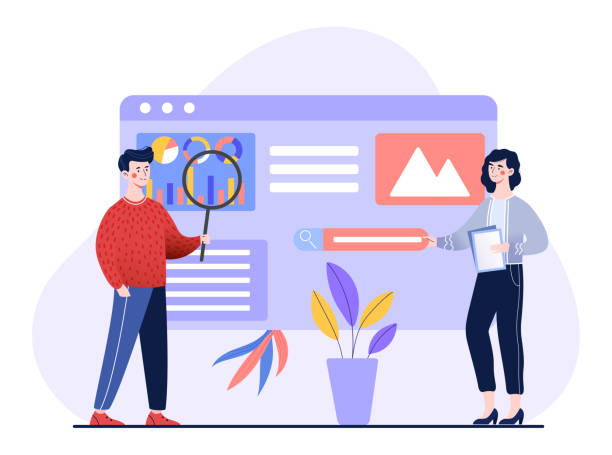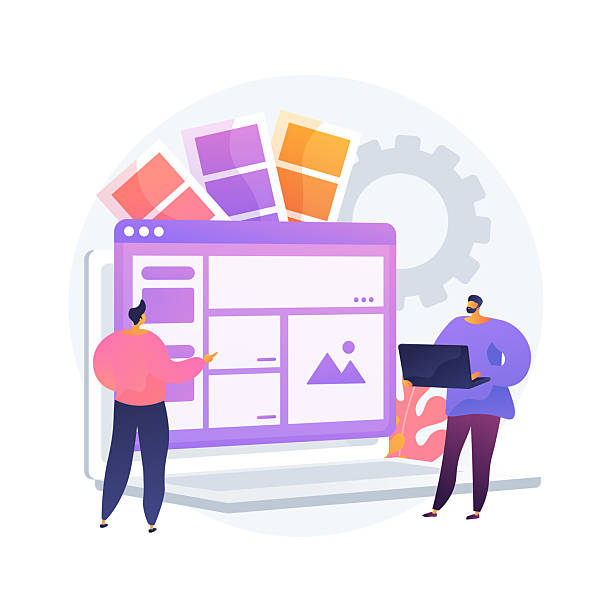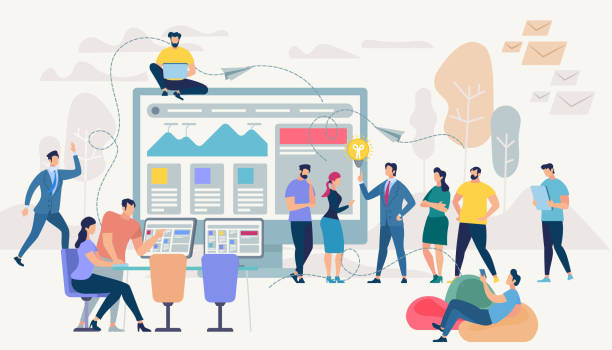Introduction to the Importance of E-commerce Website Design in Today’s World

In the current era, where #internet has become an inseparable part of daily life, having a strong #online_presence is vital for any business.
This importance is doubled especially for stores and service businesses.
E-commerce website design is no longer just a competitive advantage, but a necessity that allows you to offer your products and services beyond geographical limitations to potential customers worldwide.
An #online_store acts as a 24-hour branch of your business, providing customers with the ability to purchase at any time and place without the need for physical presence.
This approach not only brings about #increased_sales and access to new markets but also helps in #improving_branding and establishing a deeper connection with customers.
The first step in this path is choosing an expert team or individual for e-commerce website design who can transform your visions and goals into a digital reality.
This process includes selecting the right platform, designing an attractive and user-friendly interface, optimizing for search engines, and integrating secure payment systems.
Without a professional e-commerce website, many opportunities for business growth and development will be lost.
Are you concerned about your e-commerce website’s low conversion rate and not achieving your desired sales?
Rasaweb is your specialized solution for having a successful e-commerce website.
✅ Significant increase in conversion rates and sales
✅ Professional and user-friendly design to gain customer satisfaction
⚡ Ready for a transformation in online sales? Get a free consultation!
Key Features of a Successful E-commerce Website Design

For an e-commerce website design to be successful and meet business and customer expectations, special attention must be paid to several key features.
The first and most important feature is a strong User Interface (UI) and User Experience (UX).
The website should be designed in such a way that navigation is easy, products are easily found, and the purchasing process is seamless.
High loading speed is also of great importance; today’s customers have little patience, and any delay can lead to lost sales.
Responsiveness (Responsive Design) is also crucial, meaning the site should display well on all devices, including mobile, tablet, and desktop.
Site security, especially in payments and protecting customer information, is a top priority.
Using SSL certificates and reliable security protocols is mandatory.
Furthermore, having a powerful Content Management System (CMS) that allows for easy product updates, order management, and customer tracking is very important.
The ability to filter and advanced search for products, customer reviews, and product comparison features also enhance the shopping experience.
Finally, e-commerce website design should allow for integration with marketing tools such as email marketing and web analytics to continuously monitor and improve site performance.
Choosing the Right Platform for E-commerce Website Design

One of the most important decisions in e-commerce website design is choosing the right platform (CMS).
This choice will directly impact the site’s future capabilities, scalability, costs, and ease of management.
There are various platforms in the market, each with its own advantages and disadvantages, suitable for different needs.
Among the most popular options are WooCommerce, which is a WordPress plugin, Shopify as a SaaS solution, Magento for large businesses, and Opencart.
WooCommerce is an excellent option for those already familiar with WordPress and seeking high flexibility and full control over their site, but it requires more technical knowledge for setup and maintenance.
Shopify is a ready-to-use and user-friendly solution that requires little technical knowledge and allows for quick online store setup, but it offers less flexibility in customization, and its monthly costs can be high.
Magento is suitable for large companies with complex needs and offers very powerful capabilities, but it requires experienced specialists and high costs.
Ultimately, platform selection should be based on your budget, business size, number of products, customization needs, and your team’s technical knowledge.
A specialist consultant in e-commerce website design can provide valuable guidance in this area.
Comparison of Common E-commerce Website Design Platforms
| Platform | Advantages | Disadvantages | Suitable for |
|---|---|---|---|
| WooCommerce | High flexibility, full control, large user community | Requires technical knowledge, hosting maintenance costs | Small and medium businesses, developers |
| Shopify | User-friendly, quick setup, strong support | Monthly cost, customization limitations, platform dependency | Startups, businesses without technical knowledge |
| Magento | Powerful, scalable, advanced features | Complex, expensive, requires professional specialists | Large companies, enterprises |
The Importance of User Experience (UX) in E-commerce Website Design Process

User Experience (UX) in e-commerce website design is more important than anything else.
A good UX can make the difference between a curious visitor and a loyal customer.
UX refers to all user interactions with your website, from the moment of entry to finalizing a purchase and even beyond.
A website with excellent UX should be visually appealing, intuitive and easy to navigate, and make the purchasing process as simple and fast as possible.
This includes items such as logical product categorization, efficient search filters, high-quality images, detailed product descriptions, and a minimal-step payment process.
Can users easily find the product they are looking for? Is the add-to-cart and checkout process unambiguous and fast? These are questions that must be answered in UX design.
Any friction or confusion during the purchase journey can lead to cart abandonment and lost sales.
E-commerce website design with a focus on UX not only increases conversion rates but also builds customer trust and loyalty.
Mobile optimization, high loading speed, and transparent information on pricing, inventory, and shipping options are all vital elements of a successful UX that must be considered at every stage of website development.
Are you worried about losing customers because you don’t have a professional e-commerce website?
With e-commerce website design by Rasaweb, forget these worries!
✅ Significant increase in sales and conversion rate from visitor to customer
✅ Professional and user-friendly design that builds customer trust
⚡ Get a free consultation from Rasaweb
Security and Payment Gateways in E-commerce Website Design

In the world of e-commerce, security is paramount, especially when it comes to customers’ financial and personal information.
In the process of e-commerce website design, security provision must be at its core from the very beginning.
The use of an SSL (Secure Sockets Layer) certificate to encrypt data exchanged between the user and the server is an absolute necessity.
This certificate not only protects customer information but also positively impacts site SEO.
In addition to SSL, other security protocols such as PCI DSS (Payment Card Industry Data Security Standard) should be used if processing cards directly.
Choosing the right payment gateway is also of great importance.
Payment gateways must be secure, reliable, and efficient so that customers can complete their purchases with peace of mind.
There are various options for payment gateways, including direct bank gateways and reputable payment intermediaries.
Each of these has its own advantages and disadvantages that should be chosen based on the type of business and target audience.
Furthermore, having a robust system to prevent online fraud and scams, as well as regular backups of site data, are other important aspects of security in building an online store.
Transparent communication regarding privacy policies also helps build customer trust.
Search Engine Optimization (SEO) to Increase E-commerce Website Traffic

After completing e-commerce website design, the next crucial step is Search Engine Optimization (SEO).
Without strong SEO, even the best online store might not be seen among a multitude of competitors.
The main goal of SEO is to increase your site’s ranking in Google search results and other search engines for keywords related to your products.
This process includes On-page SEO and Off-page SEO.
On-page optimization includes using appropriate keywords in page titles, meta descriptions, URLs, product text, and image descriptions.
Also, the site structure should be clear and understandable for search engines, and page loading speed should be high.
Creating high-quality and relevant content for each product or product category, as well as blogging in your industry, significantly helps attract organic traffic.
Off-page optimization involves building quality links from other websites to your site (backlinks).
This process must be continuously monitored, and with changes in Google’s algorithms, the SEO strategy must also be updated.
A strong SEO strategy for your business website creation ensures that potential customers can easily find you, which means increased traffic and ultimately, increased sales.
Marketing and Advertising Strategies to Increase Online Sales

Merely designing an e-commerce website is not enough for success; to attract customers and increase sales, you need targeted marketing and advertising strategies.
Digital marketing provides you with various tools to reach your target audience.
One of the most effective methods is content marketing; creating valuable and engaging content (such as blog articles, videos, guides) that not only introduces your products but also answers customer questions and needs and entertains them.
Social media advertising (such as Instagram, Telegram, Facebook) is also very powerful because it allows you to target specific audiences based on their interests, demographics, and behavior.
Email marketing is an effective tool for communicating with existing customers and sending newsletters, special offers, and abandoned cart reminders.
Collaborating with influencers, running discount campaigns and contests, and providing excellent customer service also helps attract and retain customers.
Every marketing campaign must be carefully monitored and analyzed to measure its effectiveness and optimize strategies.
These continuous marketing efforts, alongside a good online sales platform, are the key to success in today’s competitive landscape.
Checklist of Digital Marketing Strategies for E-commerce Websites
| Strategy | Short Description | Importance |
|---|---|---|
| Content Marketing | Producing articles, videos, infographics to attract traffic | Increased brand awareness, improved SEO, attracting loyal audience |
| Social Media Advertising | Targeted campaigns on platforms like Instagram and Facebook | Reaching a broad audience, increasing engagement, lead generation |
| Email Marketing | Sending newsletters, special offers, cart reminders | Customer retention, increased loyalty, improved conversion rates |
| SEO (Search Engine Optimization) | Optimizing the site for search engines to achieve higher rankings | Free and targeted organic traffic, brand credibility |
Common Challenges in E-commerce Website Design and Solutions

On the path of e-commerce website design, you will encounter numerous challenges, and understanding and preparing for them can help you prevent and solve problems.
One of the most common challenges is lack of traffic; even an excellent site without visitors will be useless.
The solution to this problem is investing in strong SEO, content marketing, and targeted digital advertising.
Another challenge is the high cart abandonment rate.
This usually occurs due to the complexity of the payment process, hidden costs, or lack of transparency in shipping.
Simplifying the payment process, offering diverse shipping options, and transparency in pricing can largely resolve this issue.
Site security is also a constant concern.
Hacking or data breaches can severely damage brand credibility.
The solution is to always use SSL certificates, keep plugins and themes updated, and use strong passwords and intrusion detection systems.
The problem of poor customer support can also lead to customer dissatisfaction.
Implementing online chat, providing contact numbers and support emails, and promptly responding to customer questions and issues are crucial.
Finally, intense competition in the online market is a major challenge.
To stand out, you must offer a unique value proposition, prioritize the quality of your products and services, and continuously improve the user experience.
Is your current e-commerce website design not generating the expected sales for you?
Rasaweb specializes in professional e-commerce website design!
✅ An attractive and user-friendly website aimed at increasing sales
✅ High speed and security for an ideal shopping experience⚡ Get a free online store design consultation with Rasaweb!
The Future of E-commerce Website Design and Emerging Trends
![]()
The world of e-commerce is constantly evolving, and e-commerce website design is no exception.
A future full of innovation awaits e-commerce websites.
One of the most important trends is deeper Personalization; websites use AI and machine learning to display content, products, and even discount offers completely personalized based on user purchase history and behavior.
This improves the shopping experience and increases conversion rates.
Augmented Reality (AR) and Virtual Reality (VR) will also play an increasing role; for example, customers can virtually try on clothes or view furniture in their homes.
Social Commerce, which is direct purchasing through social platforms, and Voice Commerce via voice assistants, are other important trends.
Sustainability and social responsibility have also become important elements in brand selection, and e-commerce websites must reflect these values.
Speed and efficiency through Progressive Web Apps (PWAs) will also gain more importance.
To maintain competitiveness, online sales platform development developers must constantly monitor these trends and implement them in their designs to provide a modern and engaging experience for customers.
Conclusion and Next Steps for Your E-commerce Website Design

As explored in this comprehensive article, e-commerce website design is more than a simple online presence; it is a strategic investment for the growth and survival of your business in the digital world.
From choosing the right platform and focusing on user experience, to ensuring security, optimizing for search engines, and running targeted marketing campaigns, every step requires careful planning and professional execution.
To succeed in this path, you must continuously monitor your site’s performance, listen to customer feedback, and be ready to keep pace with emerging trends.
The world of e-commerce is rapidly changing, and only businesses that are flexible and innovative can succeed in the long run.
The next step for you is to begin detailed planning for your e-commerce website design.
This includes defining goals, setting a budget, choosing a development team or platform, and formulating initial marketing strategies.
Remember that a successful e-commerce website is a full-fledged project that requires continuous attention and constant improvement.
With a targeted and customer-focused approach, you can create a powerful and profitable e-commerce website design that not only meets your current needs but also provides the foundation for your business’s future growth.
Frequently Asked Questions
| Question | Answer |
|---|---|
| What stages does e-commerce website design include? | Needs analysis, appearance and user interface (UI/UX) design, front-end and back-end development, payment gateway integration, testing, and launch. |
| What features should a good e-commerce website have? | Product display with details and images, shopping cart, inventory management system, filtering and search capabilities, user review system, secure payment gateway, order management section. |
| What are the advantages of having a dedicated e-commerce website? | Full control over appearance and features, stronger branding, direct customer communication, independence from other platforms, SEO optimization. |
| How important is security in e-commerce website design? | It is crucial. Includes security of customer information, financial transactions (SSL), and protection against cyber attacks. |
| What does SEO mean in an e-commerce website? | Optimizing the site for search engines so that your products and pages achieve a good ranking in Google and other search engine results, attracting more users. |
And other services of Rasaweb Advertising Agency in the field of advertising
Smart SEO: Professional optimization for campaign management using intelligent data analysis.
Smart Brand Identity: Professional optimization for digital branding using Google Ads management.
Smart Data Analysis: A fast and efficient solution to increase sales with a focus on attractive UI design.
Smart Advertising Campaign: A combination of creativity and technology for online growth through custom programming.
Smart Website Development: A blend of creativity and technology for user interaction through SEO-driven content strategy.
And over hundreds of other services in internet advertising, advertising consultation, and organizational solutions
Internet Advertising | Advertising Strategy | Advertorials
Resources
E-commerce Website Design Guide
How to Start an Online Store?
The Role of UI/UX in E-commerce Website Design
Cost of E-commerce Website Design
? For your business to thrive in the digital world, Rasaweb Digital Marketing Agency is your smart partner. With us, you will have a complete experience of professional services, from website design with a modern user interface to comprehensive SEO and content marketing strategies.
📍 تهران ، خیابان میرداماد ،جنب بانک مرکزی ، کوچه کازرون جنوبی ، کوچه رامین پلاک 6


